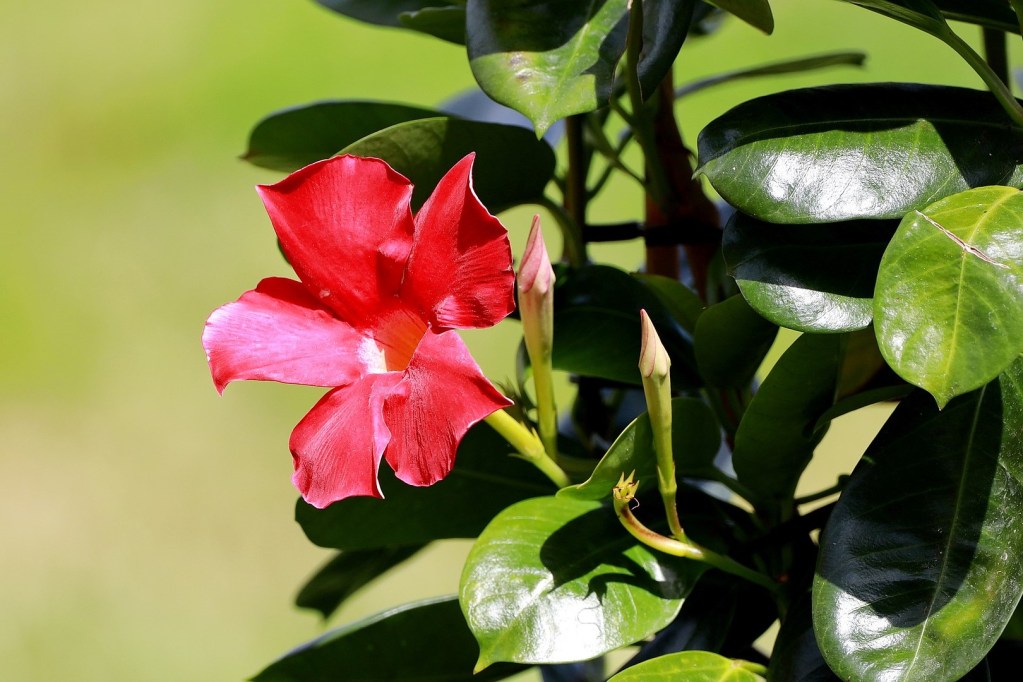
Mandevilla, also called rocktrumpet, is a beautiful tropical plant native to South America, Central America, and even the southwestern part of North America. This gorgeous flowering vine looks stunning in containers and climbing up walls or trellises. If you have a vertical garden or are planning to start one soon, then mandevilla should absolutely be on your list of plants to consider. You’ll love seeing their vibrant flowers, which come in shades of red, pink, white, and yellow. Excited to start growing your own mandevilla plants? This guide will answer all your questions, from planting to problem-solving!
Planting mandevilla

Like most tropical plants, mandevilla loves warm weather and is sensitive to the cold. Start planting yours in mid to late spring, after the last frost has passed and the weather has warmed up. Mandevillas are tender perennials, meaning they’re perennials that are often killed by cold and are therefore grown as annuals in many cooler regions. If you don’t live somewhere with warm or mild winters, consider planting your mandevilla in a container so you can move it indoors during cold weather.
Whether in a container or in your garden, plant your mandevilla in rich, well-draining soil. Sandy soil works well for mandevilla plants as well. Adding compost and sand to your soil before planting can improve the drainage of your mandevilla. Place your mandevilla plants in full sun. They can tolerate some shade, but you’ll have fewer and smaller flowers.
Finally, you’ll need to add a climbing support next to your mandevilla. A full-size trellis is great, but mandevilla will also happily climb a pole, fence, cage, or other structure as long as it is close enough to their vines.
Mandevilla care

As long as they have plenty of light, mandevilla plants are easy to care for. They need to be watered semi regularly, typically once or twice each week. During particularly hot weather, they may need more frequent watering. However, avoid watering them if the soil is still wet from the last time they were watered, and try not to get their leaves wet if possible. During spring and summer, you can feed them with a balanced fertilizer.
When your mandevilla plant is first growing, you’ll also need to help it attach to the trellis or other climbing support. You can use any type of soft garden tie, which you can find in garden supply stores, to secure the vine to the trellis. Don’t tie the vine too tightly! It should fit loosely around the vine to support it without cutting into it. You can remove the ties after a couple of weeks, once the vine is able to support itself on the trellis.
Common problems with mandevilla

Common garden pests like aphids, mites, whiteflies, and caterpillars can all bother mandevilla from time to time. The damage is typically cosmetic, meaning it impacts the plant’s appearance rather than its health. However, if a large infestation is weakening your mandevilla, then using neem oil or insecticidal soap on the leaves can help prevent further damage. Avoid using chemical sprays near the flowers, as they can harm the pollinators that enjoy mandevilla.
The more concerning problems mandevilla can develop on the stems is from water-related issues. Overly wet soil, wet leaves, and hot, humid weather can lead to fungal infections. Root rot is a problem for overwatered mandevilla, so planting it in well-draining soil and taking care when watering it are the best ways to prevent it.
Anthracnose is a common fungal infection that you may have seen on pepper or tomato plants. The main symptom is dark, spreading spots on the leaves, stems, and even flowers. The fungal spores grow when the plant’s leaves become wet, and are spread as the water drips from one leaf to another. Water your mandevilla plants below the leaves to lower the risk. If you notice anthracnose spots, remove the infected parts of the plant with sharp, clean shears. Be sure to wash the shears before and after using them, to prevent the spores from spreading.
Mandevilla companion plants

Mandevilla can be planted alongside most flowers that appreciate full sun, warm weather, and regular watering. Keep in mind that if you choose another climbing plant, you’ll need a climbing structure large enough for both plants. Mandevilla looks particularly stunning alongside hibiscus, lantana, bougainvillea, and vinca. These are also all brightly colored flowers that are highly attractive to pollinators, including bees, butterflies, and hummingbirds. Avoid plants that prefer deep shade or are sensitive to water, such as ferns, morning glories, and cacti. Smaller plants that prefer light shade or mixed shade might be able to grow around the base of your mandevilla, if the plant and its trellis cast enough shade.
Mandevilla is a gorgeous plant that is surprisingly easy to grow. While most gardeners grow it an annual, you can actually grow it as a perennial if you can keep it warm through winter. This means you can have year after year of strikingly vibrant flowers and all the pollinators that visit them! Whether you plan on growing your mandevilla for only a couple of seasons or want to make it one of your garden staples, you’re sure to be delighted by this lovely plant.



